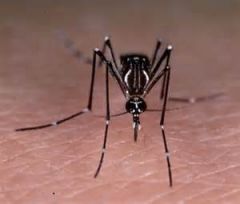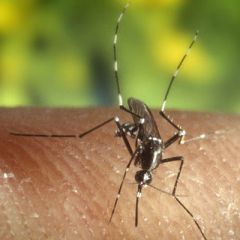![]()
![]()
![]()
Use LEFT and RIGHT arrow keys to navigate between flashcards;
Use UP and DOWN arrow keys to flip the card;
H to show hint;
A reads text to speech;
24 Cards in this Set
- Front
- Back
|
What are the maintenance hosts, amplifiers hosts and incidental hosts in arboviruses?
|
Maintenance: Wildlife (mammals, birds, reptiles etc.)
Domestic animals are amplifiers Man is incidental host |
|
|
Two main arbovirus vectors? |
Aedes and Culex |
|
|
Aedes aegypti. Features of larvae: Where do they rest? When do they feed? |

Adult: Black and white and "lyre" pattern on thorax. Lie parallel Larvae: Short fat siphon, Thrives in containers, around the home. Rest: Indoors/Around the home. Feed: On humans only, diurnally active, indoors and around the house. Flight: Rarely >100m |
|
|
Aedes aegypti. Principle vector of..? (4) |
Zika Yellow Fever (urban) Chikungunya Dengue |
|
|
Aedes albopictus. Environments? Active where and when? Interesting issues? |

Vector for dengue and zika. (not important in YF)
Mainly rural, peri-urban and sometimes urban. Diurnally active, mainly outdoors. Range of hosts in addition to humans. Responsible for epidemics of dengue/chikingunya outbreaks in Europe as becoming more common. However generally not an incredibly effective vector so not important for rise in zika and dengue. |
|
|
How did yellow fever spread to humans? |
Originally "Jungle" cycle with monkey reservoirs transmitted between themselves mosquito vectors (e.g. Aedes Africanus) that only bite monkeys. |
|
|
3 main control methods for Yellow Fever? |
Case finding Mass vaccination Vector control (Rare today) |
|
|
Culex. Feed when and on what? Stay where? Problem? Breeding sites? |
Brown/Dull
Feed at night and will feed readily on birds, pigs and humans. Stay both indoor and outdoors Often the most apparent mosquitoes in a locality as very, very annoying. C.Tritaeniorhynchus typically breeds in rice fields/drainage ditches. |
|
|
Main vector for Japanese Encephalitis? |
Culex tritaeniorhnchus (and other Culex species) |
|
|
Japanese encephalitis. Amplifier hosts? |
Maintenance: Aquatic birds Amplifier: Pigs |
|
|
Control of JE.
Vaccination vs Vector |
Vaccination: Humans and Pigs (Humans method of choice) |
|
|
Dengue. Why increase? Vaccine? |
Massive increase due to urbanisation and travel New vaccine not active against all serovars. Vector control: Larviciding --> Probably never going to fully take off. Originally organophosphate used now safe treatments such a pyriproxyfen. Education and community involvement. Fogging --> Does not work. LLIN --> No evidence. |
|
|
Promising tools for future aedes aegypti control? |
1. Control of immature stages (Safe insecticides such as pyriproxyfen) 2. Control of adult mosquitoes --> Physical barrier and IRS 3. Innovative methods: GM mosquitoes. Using wolbachia symbiont infection to drive refractory genes into population |
|
|
Life cycle of mosquitoes in general. Starting at blood feed. |
After blood feed --> Eggs laid after 3-4 days. Larvae hatch from eggs after 2-3 days. Larvae feed on microorganisms and grow through 4 instars. Pupae form after 5-7 days. |
|
|
Endophagy vs Exophagy. Endophily vs Exophily (resting) |
Exo - Outside (e.g. Arabiensis) Endo - Inside (e.g. Gambiae) |
|
|
How long on average does it take for a mosquito to become infective? |
10-14 days
|
|
|
What is the sporozoite rate? |
%mosquitoes infective or infectious
Typically 5% in An.Gambiae in AFrica Detect either by: Dissection and microscopy for sporozoites ELISA PCR |
|
|
Vectorial capacity. Essentially what is the numerator and the denominator? |
Numerator --> Man biting rate (Dependent on density of vectors to man and biting rate) x Probability of daily survival (to the power of incubation of parasite)
Denominator --> Log of probability of survival. |
|
|
What are the advantages of targeting adult mosquitoes with IRS and ITNs? (3) |
Very large number of breeding sites can make larval control unrealistic Aquatic breeding sites require very frequent treatment. However last a long time on walls and nets. Maturation of the parasite takes 10-12 days. Has a number of feeds in that time and therefore more and more chance of death. |
|
|
What class of insecticide is the only one recommended for nets? How long will they last? |
Pyrethroids and will last <5 years. |
|
|
Insecticides for mosquitoes. |
Pyrethroids in the 70s (Permethrin). No new since! Only new in class. |
|
|
Larval Control What 2 main ways are there. |
Source reduction:
Cover water, drain areas, remove objects filled with water. Difficult and expensive to do. Sometimes impossible or too environmentally degrading. Certain chemical larvicides - Temephos Can cover areas with oil Can use biologicals such as Bacilius Thuringiensis (Specific to blackfly, midges and mosquitoes) Insect growth regulators (methoprene) |
|
|
What is zooprophylaxis? |
In areas with animal seeking vectors --> Can use insecticides on the domestic animals. |
|
|
Other personnel protection from mosquitoes apart from LLIN/ITNs? |
Coils. Deet Fogging |

